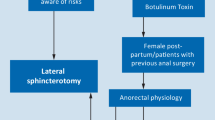Abstract
Anal fissure is a tear in the lining of the anal canal distal to the dentate line, which most commonly occurs in the posterior midline. Anal fissure was defined chronic if the patient presented with history of anal pain during defecation for at least 2 months with the observation of sphincter fibers at the base of the lesion. One hundred and forty-two consecutive patients with a chronic anal fissure with hypertonicity of internal sphincter on proctological examination were selected for this study from October 2008 to October 2010. Patients enrolled for the study were randomized to two groups by using a computer-generated list. Patients who underwent lateral internal sphincterotomy (LIS) were operated as day surgery procedures under local or epidural anesthesia. Patients randomized to conservative treatment were prescribed to use warm anal dilator with a nifedipine ointment 5 min twice daily for 4 weeks. Patients were clinically examined after 2, 4 and 8 weeks of treatment to evaluate if there was complete healing of the fissure. All patients were required to record pain after the first defecation, on 3rd and 7th postoperative day on a self-administered VAS scale in cm (0–10). Sixty-eight patients were randomly assigned to LIS, 74 to the conservative approach. Fifty-one patients of topical nifedipine group (68.9 %) and 60 patients of LIS group (88.2 %) presented an anal fissure healed at 8 weeks with a p value of 0.0077. As regards post-operative pain, 43 patients of LIS group (63.2 %) and 25 patients of topical nifedipine group (33.7 %) referred first defecation as painless. In the topical nifedipine group 43 (58.1 %) after 3 days since treatment and 35 (47.3 %) after 7 days had pain. In the LIS group 22 (32.3 %) after 3 days and 9 (13.2 %) after 7 days referred pain. There was no statistical difference between LIS and topical nifedipine group concerning side effects. Lateral internal sphincterotomy is an effective, less painful, fast recovery treatment for chronic anal fissure. Incontinence rate is overestimated and often the fear of a continence disturbance, albeit with a low incidence following surgery, may obscure the need to relieve symptoms which may be so severe as to make the patient’s life intolerable.
Similar content being viewed by others
References
Brisinda G, Cadeddu F, Brandara F, Brisinda D, Maria G (2004) Treating chronic anal fissure with botulinum neurotoxin. Nat Clin Pract Gastroenterol Hepatol 1:82–89
Lund JN, Scholefield JH (1996) Aetiology and treatment of anal fissure. Br J Surg 83:1335–1344
Zaghiyan KN, Fleshner P (2011) Anal Fissure. Clin Colon Rectal Surg 24:22–30
Nothmann BJ, Schuster MM (1974) Internal anal sphincter derangement with anal fissure. Gastroenterology 67:216–220
Hancock BD (1977) The internal sphincter and anal fissure. Br J Surg 64:92–95
Klosterhalfen B, Vogel P, Rixen H, Mittermayer C (1989) Topography of the inferior rectal artery: a possible cause of chronic, primary anal fissure. Dis Colon Rectum 32:43–52
Schouten WR, Briel JW, Auwerda JJ, De Graaf EJ (1996) Ischaemic nature of anal fissure. Br J Surg 83:63–65
Tranqui P, Trottier DC, Victor JC, Freeman JB (2006) Nonsurgical treatment of chronic anal fissure: nitroglycerin and dilatation versus nifedipine and botulinum toxin. Can J Surg 49:41–45
Abcarian H (1980) Surgical correction of chronic anal fissure: results of lateral internal sphincterotomy vs fissurectomy-midline sphincterotomy. Dis Colon Rectum 23:31–36
Nyam DC, Pemberton JH (1999) Long-term results of lateral internal sphincterotomy for chronic anal fissure with particular reference to incidence of fecal incontinence. Dis Colon Rectum 42:1306–1310
Khubchandani IT, Reed JF (1989) Sequelae of internal sphincterotomy for chronic fissure in ano. Br J Surg 76:431–434
Nelson RA (2004) Systematic review of medical therapy for anal fissure. Dis Colon Rectum 47:422–431
Altomare DF, Binda GA, Canuti S, Landolfi V, Trompetto M, Villani RD (2011) The management of primary chronic anal fissure: a position paper. Tech Coloproctol 15:135–141
Golfam F, Golfam P, Khalaj A, Mortaz SSS (2010) The effect of topical nifedipine in treatment of chronic anal fissure. Acta Medica Iranica 48:295–299
Perrotti P, Bove A, Antropoli C, Molino D, Antropoli M, Balzano A, De Stefano G, Attena F (2002) Topical nifedipine with lidocaine ointment vs. active control of treatment of chronic anal fissure: results of prospective, randomized, double blind study. Dis Colon Rectum 45:1468–1475
Brown CJ, Dubreuil D, Santoro L, Liu M, O’Connor BI, McLeod RS (2007) Lateral internal sphincterotomy is superior to topical nitroglycerin for healing chronic anal fissure and does not compromise long-term fecal continence: six-year follow-up of a multicenter, randomized, controlled trial. Dis Colon Rectum 50:442–448
Parellada C (2004) Randomized, prospective trial comparing 0.2 percent isosorbide dinitrate ointment with sphincterotomy in treatment of chronic anal fissure: a two-year follow-up. Dis Colon Rectum 47:437–443
Oshiro H, Kobayashi I, Kim D, Takenaka H, Hobson RW 2nd, Duran WN (1995) L-type calcium channel blockers modulate the microvascular hyperpermeability induced by platelet-activating factor in vivo. J Vasc Surg 22:732–741
Katsinelos P, Papaziogas B, Koutelidakis I, Paroutoglou G, Dimiropoulos S, Souparis A (2006) Atmatzidis K Topical 0.5% nifedipine vs. lateral internal sphincterotomy for the treatment of chronic anal fissure: long-term follow-up. Int J Colorectal Dis 21:179–183
Conflict of interest
None.
Author information
Authors and Affiliations
Corresponding author
Rights and permissions
About this article
Cite this article
de Rosa, M., Cestaro, G., Vitiello, C. et al. Conservative versus surgical treatment for chronic anal idiopathic fissure: a prospective randomized trial. Updates Surg 65, 197–200 (2013). https://doi.org/10.1007/s13304-013-0217-0
Received:
Accepted:
Published:
Issue Date:
DOI: https://doi.org/10.1007/s13304-013-0217-0




